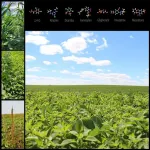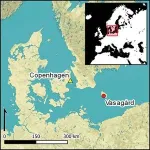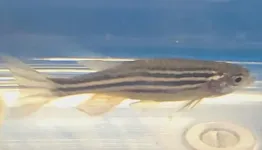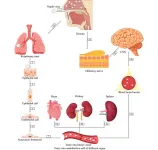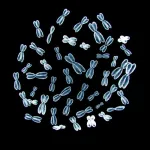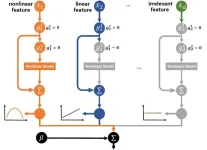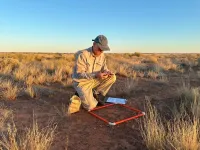(Press-News.org) WESTMINSTER, Colorado – 16 January 2025 – Recently published research in the journal Weed Science shows promise for controlling herbicide-resistant weeds in soybean fields by using a seed impact mill at harvest. When installed on a combine, this harvest weed-seed control system (HWSC) mechanically damages weed seeds as they move through the mill to render them non-viable.
Iowa State University Researchers Alexis Meadows and Ram (Ramawatar) Yadav conducted seed impact mill field experiments during 2021 and 2022 on a commercial farm near Gilbert, Iowa. “Altogether, impact mill treatment reduced the number of germinable seeds by 87% compared with the no–impact mill treatment,” says Yadav, a Ph.D. Weed Science Society of America (WSSA) member, and a specialty crop weed science assistant professor at The Ohio State University. “These results indicate that seed impact mills can be a useful tool in soybean production to help manage multiple herbicide–resistant waterhemp populations.”
The HWSC technology used for the study was a Redekop™ Seed Control Unit, mounted on the rear of the combine. “Although the impact mill did not severely damage all of the waterhemp seeds, moderate damage to seeds was effective in reducing seed germination and viability in controlled conditions,” notes Yadav. “Furthermore, seeds with moderate damage are less likely to persist in the soil seedbank due to increased seed mortality.”
Ongoing research shows show that multiple herbicide–resistant weed populations continue to grow in scope in Midwestern U.S. production fields. Thus, keeping their seedbank density low is critical for future herbicide-resistance management.
By adding seed impact mill technology to current weed-control practices, researchers estimate future herbicide-resistant populations could be delayed by five to eight years. “Mainstream weed management programs for U.S. soybean production typically do not include a late-season weed-control strategy,” points out Yadav. “As a result, weed escapes/survivors are the primary source of seedbank replenishment. Implementation of seed impact mills in the current system would diversify the weed-control strategies in use and might delay the development of herbicide-resistant populations.”
However, Yadav cautions that this technology is not the sole answer to herbicide-resistant waterhemp management. “Implementation of HWSC methods in Iowa cropping systems is not a replacement of existing weed control tactics but rather an expansion of the weed management toolbox,” he says. “All weed control tactics have limitations, and overreliance on a single tactic may increase weed control failures. It is likely that overreliance on HWSC methods will lead to the selection of early seed-shattering weed biotypes.”
The good news is that other non-chemical weed control tactics can also work in tandem with herbicide treatments, in addition to seed impact mills, to effectively manage herbicide-resistant waterhemp, says Yadav. Other effective non-chemical weed control tactics include implementing a cereal rye cover crop and narrow-row soybean production systems, he adds.
“These practices have shown to be effective in managing herbicide-resistant waterhemp in soybean and therefore should be used in conjunction with HWSC methods to spread the risk of weed control failures,” he says. “Future research should focus on the long-term impact of integrating HWSC methods on waterhemp life-history traits, including its seedbank persistence.”
This project was led by Alexis Meadows, a former M.S. student in the Department of Agronomy at Iowa State University.
More information is available in the article, “Using a seed impact mill to limit waterhemp (Amaranthus tuberculatus) seed inputs in Iowa soybean.” The research is featured in Volume 72, Issue 6 of Weed Science, a Weed Science Society of America journal, published online by Cambridge University Press.
About Weed Science
Weed Science is a journal of the Weed Science Society of America, a nonprofit scientific society focused on weeds and their impact on the environment. The publication presents peer-reviewed original research related to all aspects of weed science, including the biology, ecology, physiology, management and control of weeds. To learn more, visit www.wssa.net.
Media Contact:
Jo Skelton
Senior Brand and Partner Communications Manager
cupacademic@cambridge.org
01223326165
Published by Cambridge University Press on behalf of the Weed Science Society of America' when mentioning the journal Cambridge University Press is the academic and Bibles publisher of Cambridge University Press & Assessment. It publishes books and journals, serving customers in higher education through research, education products and services. It is part of the University of Cambridge, delivering trusted research and learning materials that spread knowledge, spark curiosity and aid understanding of the world we live in.
END
Study shows seed impact mills clobber waterhemp seed viability
2025-01-16
ELSE PRESS RELEASES FROM THIS DATE:
Study links rising suicidality among teen girls to increase in identifying as LGBQ
2025-01-16
Amid an increase in suicidal behavior among teen girls, new research links this phenomenon to the significant increase in the number of female students identifying as lesbian, gay, bisexual, or questioning (LGBQ).
“This finding suggests that the overall increase in female suicidality is not due to all female students becoming more suicidal, but rather to a larger proportion of students being part of a group that has historically experienced higher rates of suicidal thoughts and behaviors due to social and structural pressures,” says lead author Joseph Cimpian, ...
Mind’s eye: Pineal gland photoreceptor’s 2 genes help fish detect color
2025-01-16
We see color because photoreceptor cones in our eyes detect light waves corresponding to red, green, and blue, while dimness or brightness is detected by photoreceptor rods. Many non-mammalian vertebrates like fish, however, are known to detect color and brightness with the pineal gland, which is part of the brain. An Osaka Metropolitan University research group has further elucidated on how the pineal organ of fish do so.
Previously, the research group led by Professor Akihisa Terakita and Professor Mitsumasa Koyanagi of the Graduate School of Science revealed that ...
Nipah virus: epidemiology, pathogenesis, treatment, and prevention
2025-01-16
Nipah virus (NiV), a zoonotic paramyxovirus with significant human health implications, has garnered considerable attention due to its high fatality rates and potential for human-to-human transmission, posing a global public health threat. Emerging in South and Southeast Asia, NiV is known for its recurrent outbreaks, with a particular focus on its genetic lineages, NiV-MY and NiV-BD, which differ in pathogenicity and transmissibility. The virus, initially isolated in Malaysia in 1998, has since caused outbreaks linked to contact with infected ...
FDA ban on Red Dye 3 and more are highlighted in Sylvester Cancer's January tip sheet
2025-01-16
FDA BANS RED DYE 3 IN FOOD AND INGESTED DRUGS
Citing two studies linking Red Dye 3 to cancer in laboratory male rats, the FDA today revoked authorization for the use of the dye in food and ingested drugs. The move came in response to a 2022 color additive petition. “This is long overdue,” said Tracy Crane, Ph.D., RDN., director of Lifestyle Medicine and Prevention at Sylvester. “Red Dye 3 has been banned for use in cosmetics and topical drugs for more than three decades,” she said. “Yet it gives more than 9,000 foods in the United States their red coloring. These colorful foods and drinks are particularly appealing to young children,” ...
Mapping gene regulation
2025-01-16
KYOTO – An international team of researchers has taken an important step toward understanding how gene expression is controlled across the human genome. A new study has comprehensively analyzed “cis-regulatory elements” (CREs), which are the DNA sequences that regulate gene transcription. This work sheds light on how these elements contribute to cell-specific gene expression and how mutations within them may influence health and disease.
CREs, including enhancers and promoters, are essential for controlling when and where genes are ...
Exposure to air pollution before pregnancy linked to higher child body mass index, study finds
2025-01-16
In a study of more than 5,000 mothers and their children, exposure to air pollution during the three months before pregnancy predicted higher child body mass index (BMI) and related obesity risk factors up to two years of age. Findings from the study, which was supported by the National Institute of Environmental Health Sciences, were published in the journal Environmental Research.
Past research has linked air pollution exposure during pregnancy to a broad range of health problems in children, including respiratory ...
Neural partially linear additive model
2025-01-16
Interpretability has drawn increasing attention in machine learning. Partially linear additive models provide an attractive middle ground between the simplicity of generalized linear model and the flexibility of generalized additive model, and are important models for addressing the two interpretability problems of feature selection and structure discovery. The existing partially linear additive models still have various imperfect performances in terms of fitting ability.
To solve the problems, a research team lad by Han LI published their new research on 15 December 2024 in Frontiers of Computer Science co-published by Higher Education Press and Springer Nature.
The ...
Dung data: manure can help to improve global maps of herbivore distribution
2025-01-16
Researchers have used dung records to create high-resolution maps of herbivore distribution around the world. Their new study, recently published in Nature Food, reveals a strong positive relationship between dung presence and grazing pressure, meaning the amount of dung found in a particular location could help us understand approximately how many herbivores live there.
Many people consider dung simply as the manure left behind by horses and cows at country shows, or something to be avoided when you visit the cousins’ farm. But dung is actually an important resource for millions of people worldwide.
Dung ...
Concerns over maternity provision for pregnant women in UK prisons
2025-01-16
Senior midwives and researchers with experience in criminal and social justice are among those calling for improved maternity provision for pregnant women in UK prisons.
In an article published by The BMJ today, Laura Abbott and colleagues highlight gaps in clinical care for pregnant women and say the systemic problems need tackling urgently to protect the health of pregnant women, new mothers, and babies while in criminal justice settings.
Figures from April 2023 to March 2024 show that 229 pregnant women ...
UK needs a national strategy to tackle harms of alcohol, argue experts
2025-01-16
The UK needs an overarching national strategy to tackle alcohol related harms, argue experts in The BMJ today, as deaths from alcohol in England reach their highest level on record.
Julia Sinclair at the University of Southampton and colleagues warn that successive government cuts have led to reduced provision and quality of alcohol treatment, and say sustained funding is needed for screening and care, while industry must also shoulder some of the costs.
Alcohol is widely available and drunk by around 80% of adults in the UK and is now well established as ...
